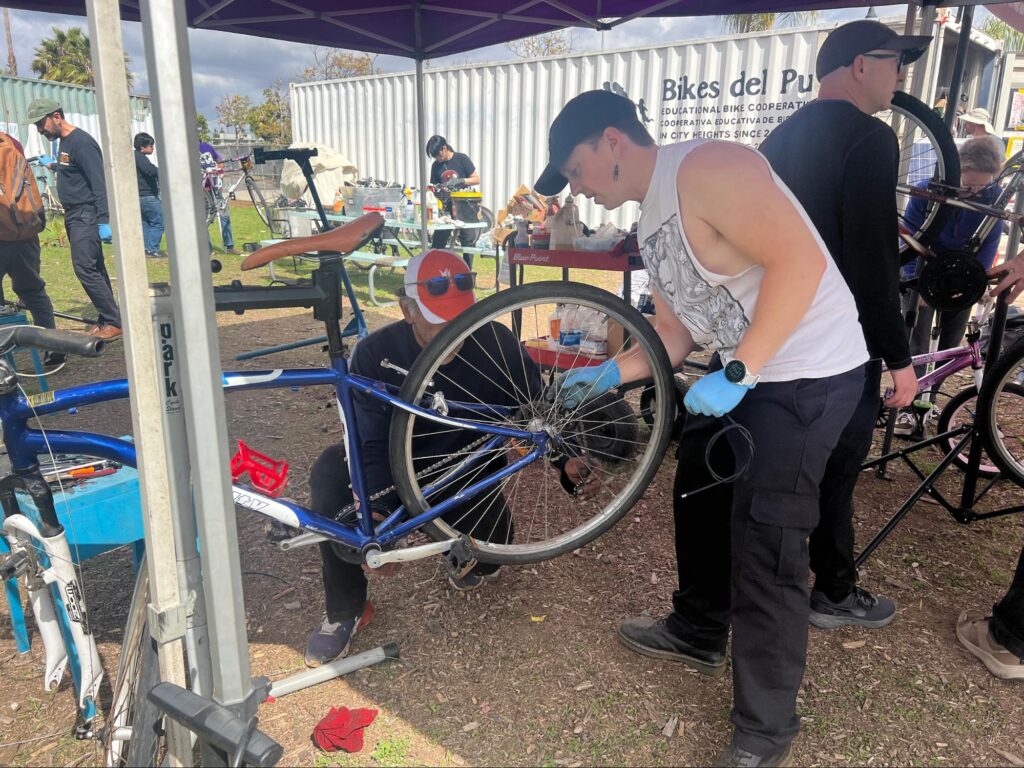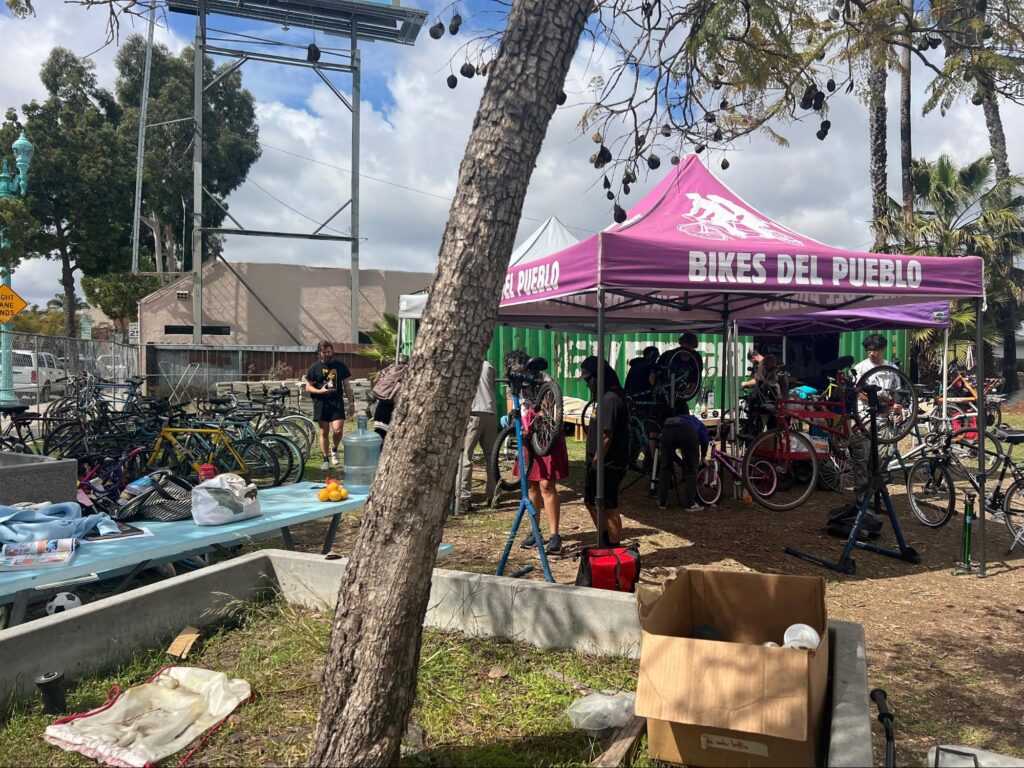
Ian Phillips is an engineering graduate student at the University of California San Diego, except on Sundays. On Sundays, he becomes a surgeon. On Sundays, he snaps on a pair of baby blue medical gloves and operates. On Sundays, instead of getting stained blood-red, his gloves turn black and greasy. On Sundays, the only day of the week Bikes del Pueblo opens its gates to its City Heights community, Phillips becomes a surgeon – for bikes.
“We’re trying to bring bikes back to life,” he said, sizing up a bicycle-in-progress.
It’s suspended on an operating table, known here as a repair stand, and it’s missing a few limbs. Its owner sits nearby, watching wordlessly. Notably, the bike rolled into the lot earlier that morning with a cracked stem, the part that affixes the handlebars to its body or frame. Phillips’ inspection determined that the stem had rusted to mush, and, being a critical structural element, it needed replacing. A fellow volunteer sawed it clean off, and Phillips replaced it with a stronger one. He fished around in the pre-loved parts container for a comfy seat, fresh tires and a set of brake levers. Now, he monitors as his teammate routes brake cables along the frame.
“The beauty of it is [that] we were able to strip every single part off the bike, except the frame, and now they live different lives,” he said. “It’s almost like an organ transplant. They live different lives on other bikes.”
Every Sunday, Phillips and a cadre of other bike enthusiasts convene in a lot dotted with shipping containers bordering the I-15 freeway in City Heights, San Diego. This is the home of Bikes del Pueblo, a co-op dedicated to getting community members on bikes. They operate using a sliding-scale donation system and work within the budgets of those accessing their services. Their shipping containers are practically overflowing with used bicycle parts that get swapped between rides every Sunday.
“We’ve grown a lot because the community puts their trust in us,” Cynthia Tecson said, toting a sign-in sheet for those filtering in through the front gates. “We do our best to welcome people who live around this area, [but] everyone’s welcome. The whole purpose of Bikes del Pueblo was to help migrants and refugees get on bikes – just ride bikes to work or do daily activities.”
Tecson greets community members at the entrance to this dedicated space while her 10-year-old daughter doodles cartoon girls at a nearby table. However, as a high school senior back in 2007, the City Heights native bore witness to Bikes del Pueblo’s earliest incarnation. While attending an organizing meeting at an art collective house in her neighborhood, she learned that some friends living there had started a new co-op centered around cycling.
“I saw a bunch of bike tools on the counter,” Tecson said. “It was just a bunch of junk at the time to me.”
From there, she explained, Bikes del Pueblo hosted one-off events at different collective houses before acquiring a weekly spot at the City Heights Farmers’ Market. When the market shuttered in 2022, the co-op moved into a vacant lot just east of the I-15 before hopping to the lot on the opposite side of the freeway last year.
Tecson wasn’t always as involved with Bikes del Pueblo; she mentioned that she took a hiatus from cycling while raising her daughter. But as her child grew up and started biking herself, Tecson naturally gravitated back toward the co-op. The tight-knit group of volunteers who directly support her City Heights community have that kind of magnetism. Plus, she added, the co-op used to be somewhat male-dominated. Since she isn’t quite as well-versed in the technical aspects of bike repair as some of her teammates, she wanted to be a female face greeting her community members up front. She wanted to encourage people from all walks of life to access Bikes del Pueblo’s services and join the team of volunteers.

“I think what makes us different than other bike shops is that we strive to make this place as inclusive as possible,” Tecson said. “There’s diversity – kids are here; there’s women of color; there’s different age groups. We have trans people. We have everyone here.”
“What I’ve heard from other community members is that [some bike shops] don’t make it welcoming,” she said. “Some people find them intimidating. There’s this culture of being cool, but here we don’t believe in that. We believe in solidarity. That’s our whole thing: solidarity, not charity.”
Of the 3.3 million residents of San Diego County, the California DMV reported in 2023 that just under 3 million motor vehicles are registered in the county. By all accounts, San Diego is a car-centric city. Its plentiful canyons present a topographically varied terrain. In most situations, unless a cyclist stays within a limited radius, commuting via bike presents a significant challenge.
“I know people that want to bike to work but don’t because they’re like, ‘Geographically, I live in the canyon. To get to work and back, I have to climb out of that every day, both ways,’” Phillips said.
Not everyone can afford a personal vehicle, however. Some people don’t have a driver’s license. Some people don’t want to drive a car, like Bikes del Pueblo’s resident mechanic, Izzy Lopez.
They used to drive a car, but after it broke down, they left it at home, unused and now unregistered. Lopez lives in Escondido but works in City Heights and National City. For their 30-mile commute, they cycle 20 minutes to the Route 235 bus, usually catching up on sleep before it drops them off near Bikes del Pueblo’s lot. From there, they cruise back streets to reach either of their jobs.
Though Bikes del Pueblo sits along the busy El Cajon Boulevard, Lopez recommends against cycling this main street and others like it across town. These roads sometimes offer shared or dedicated bike lanes, but these rarely extend farther than a couple miles at a time. Biking these streets necessitates that cyclists maintain a particularly heightened awareness of the motorists around them, not to mention potholes and other hazards.
“You have to do your research,” Lopez said. “Sometimes Google Maps is going to give you the most direct but not necessarily the safest [route]. Sometimes you’ll find a street that works, but just next to you is a more mellow backstreet.”
A fundamental tenet that Phillips, Tecson, Lopez and all the other volunteers at Bikes del Pueblo contribute to is improving bicycle literacy in their community. Mike Kleemann, a first-time visitor to the lot, analyzes the fixes that his bike received on his way out and onto the road. Just an hour prior, it had two flat tires, its seat wouldn’t adjust to his height and its gears wouldn’t switch. As he fixed it up, a volunteer had walked Kleemann through every step of the repair process.
“I imagine if I was to take this to a bike shop, they would have charged a good amount of money for everything that they did,” Kleemann said. Having listened in, a volunteer estimates it would’ve cost him $160. “They hooked me up here for free,” Kleemann added, smiling.
Kleemann left Bikes del Pueblo with a wallet that’s just as heavy as it was when he walked in and with newfound knowledge of bike maintenance. Phillips identifies the ability to repair your own bike as empowering, considering the affordability compared to car maintenance. Closing up the lot for the day, Tecson expands on this sentiment.
“I think it’s beneficial for cyclists at any level to be self-sufficient and be able to take care of their own needs,” she said. “Bike shops are pretty expensive. If you have the money, you can just drop [your bike] off and go … but you’re not really learning anything. If you’re out riding somewhere and you get a flat, what do you do? You’re on the side of the road. Maybe you’re not near a bike shop. You need to figure it out on your own. That’s what’s important here.”
As Bikes del Pueblo’s loose closing time of 2 p.m. approaches, Phillips strips off his gloves and gravitates toward a group of his fellow volunteers – his friends – chatting off to the side. Phillips doesn’t get paid for his part-time gig as a bike surgeon, but that doesn’t appear to bother him in the slightest. He’s doing something he loves.
“This is my home,” he said. “Sometimes people just want to hang out in a place that feels comfortable and welcoming, and we love that, too.”
